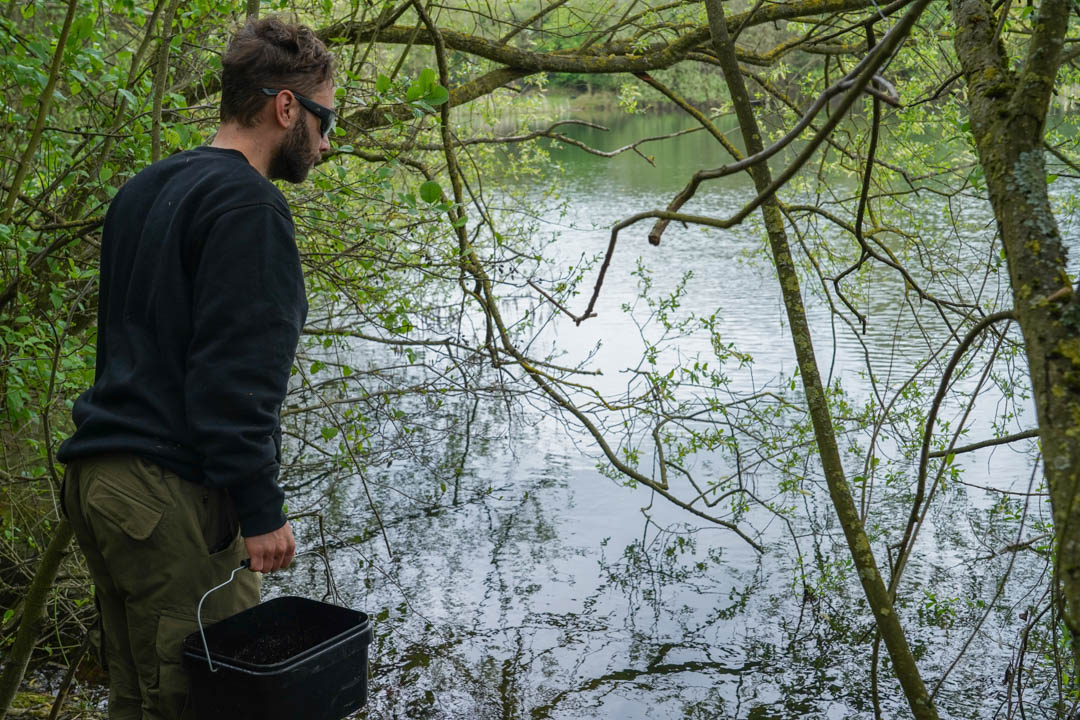Swinging into Summer
The transition from spring to summer is a favorite period in the carp fishing calendar. With longer, brighter, and warmer days, the enjoyment of observing fish and appreciating the sights of angling can be fully experienced. This period is also notable for a significant number of fish being caught, either leading up to or following spawning, with fish weights varying greatly depending on weather conditions.
In this technical feature, the focus is on a preferred tactic during this period: catching carp at close quarters. This includes fishing in the margins, on shallow bars, or in areas frequented by carp, such as bays and dense foliage like snags and lilies. The following methods and tips will help in finding productive areas of the lake.

Preparing Areas
Preparation of different areas to fish is crucial, especially on quieter lakes. This involves walking around the lake to spot fish close in and locate fishable spots near the bank. A good pair of polarizing glasses is essential for seeing directly through to the lakebed on bright days. The ideal spots are small, cleaned-off areas, about the size of a bin lid, perfect for presenting a rig and some additional bait.
Upon arriving at the lake shortly after first light, it’s beneficial to walk the lake with a bucket of bait, a catapult, and sunglasses. Check all fishable areas of snags and shallows to pinpoint any fish and introduce a few handfuls of bait to return to later in the day. Even if it takes an hour to walk the lake and bait a few spots, this effort often pays off later.
Staying Mobile
Staying mobile is essential for exploring prepared areas. Traveling light, whether for a day session or an overnight trip, makes moving around the lake easier. Carry only essential items, stripping back on gear and bait. Any spares or extra bait can be left in the vehicle for use if needed.
Fresh New Winds
Timing trips with new winds can provide opportunities to capitalize on moving fish. Often, anglers become reluctant to move once set up, allowing those arriving with new winds to take advantage. Monitoring the forecast for changes in temperature, pressure, and wind direction can be beneficial.
Using Google Maps
Google Maps is an invaluable tool for getting an alternative view of the lake. It helps identify shallower areas where carp may migrate as the water warms. This method is excellent for lakes of all sizes and helps narrow down fishing options by checking and watching areas.
Grubbing Mix
A ‘grubbing mix’ creates attraction and extends the feeding response by introducing small, highly attractive bait items on a small spot. This mix includes chopped boilies, hempseed, and frozen water snails, which keep fish feeding longer. As spring transitions to summer, this mix becomes more effective for edge fishing.
On days when finding fish close to the edge is challenging, light scatterings of bait using a catapult can attract fish to snags and bays. Later, these spots can be checked for signs of feeding activity.
Visual Tools
Eyes are the biggest asset in fishing. A good pair of polarized sunglasses is essential, along with binoculars for spotting signs of fish activity. Climbing trees or finding higher ground can provide a better view of the lake.
The Stealthy Approach
A stealthy approach is critical to avoid disturbing prepared spots. Solid PVA bags are effective for edge fishing as they create minimal disturbance when positioned correctly. These bags protect the hook and bait from debris, ensuring effective fishing.
The Solid PVA Bag
Solid PVA bags are advantageous for close-quarters fishing. They create an attractive pile of bait around the hook, eliminating the need for additional loose feed. They also ensure the rig is protected from debris, making them ideal for cloudy, close-in spots where fish feed more finicky.

Being Adaptable
Being adaptable is key. While preparing spots in the edge, also be ready to fish on the surface. Carrying a rod and minimal gear allows for quick switches from a margin baited rig to a surface setup. Prepared rigs and a spomb rod for applying floaters can make quick adaptations possible.
These methods will help catch more carp as summer progresses. Utilizing these techniques will enable adaptation and active fishing for opportunities, hopefully resulting in a few extra catches.
Images/Source: CCMoore





